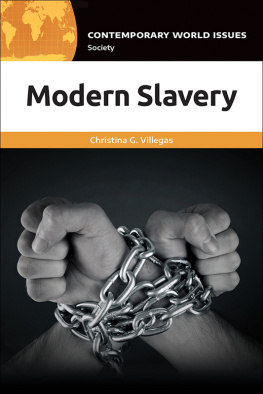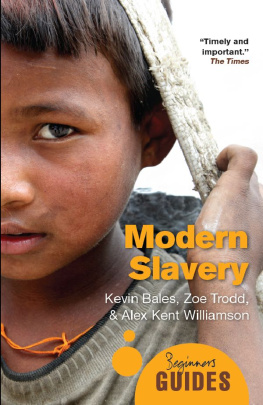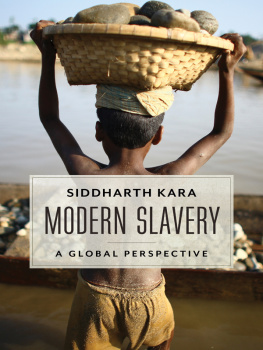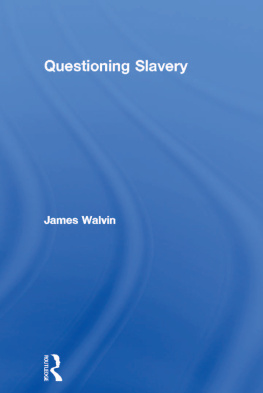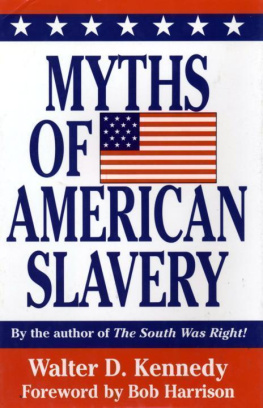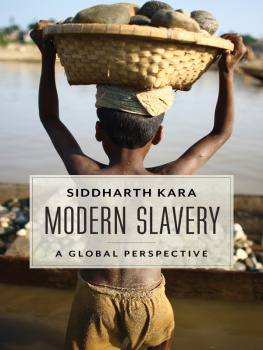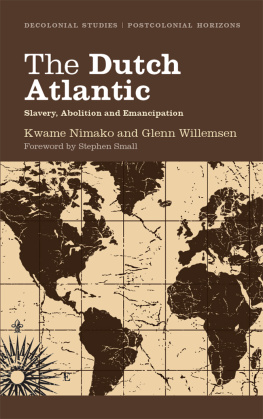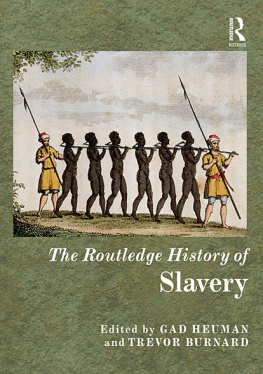Modern Slavery
Recent Titles in the
CONTEMPORARY WORLD ISSUES
Series
Immigration Reform: A Reference Handbook
Michael C. LeMay
Vegetarianism and Veganism: A Reference Handbook
David E. Newton
The American Congress: A Reference Handbook
Sara L. Hagedorn and Michael C. LeMay
Disability: A Reference Handbook
Michael Rembis
Gender Inequality: A Reference Handbook
David E. Newton
Media, Journalism, and Fake News: A Reference Handbook
Amy M. Damico
Birth Control: A Reference Handbook
David E. Newton
Bullying: A Reference Handbook
Jessie Klein
Domestic Violence and Abuse: A Reference Handbook
Laura L. Finley
Torture and Enhanced Interrogation: A Reference Handbook
Christina Ann-Marie DiEdoardo
Racism in America: A Reference Handbook
Steven L. Foy
Waste Management: A Reference Handbook
David E. Newton
Sexual Harassment: A Reference Handbook
Merril D. Smith
The Climate Change Debate: A Reference Handbook
David E. Newton
Voting Rights in America: A Reference Handbook
Richard A. Glenn and Kyle L. Kreider
CONTEMPORARY WORLD ISSUES
Modern Slavery
A REFERENCE HANDBOOK
Christina G. Villegas

Copyright 2020 by ABC-CLIO, LLC
All rights reserved. No part of this publication may be reproduced, stored in a retrieval system, or transmitted, in any form or by any means, electronic, mechanical, photocopying, recording, or otherwise, except for the inclusion of brief quotations in a review, without prior permission in writing from the publisher.
Library of Congress Cataloging-in-Publication Data
Names: Villegas, Christina G., author.
Title: Modern slavery : a reference handbook / Christina G. Villegas.
Description: Santa Barbara, California : ABC-CLIO, [2020] | Series: Contemporary world issues | Includes bibliographical references and index.
Identifiers: LCCN 2020011965 (print) | LCCN 2020011966 (ebook) | ISBN 9781440859762 (hardcover ; alk. paper) | ISBN 9781440859779 (ebook)
Subjects: LCSH: Slavery. | SlaveryHistory21st century.
Classification: LCC HT867 .V554 2020 (print) | LCC HT867 (ebook) | DDC 306.3/620905dc23
LC record available at https://lccn.loc.gov/2020011965
LC ebook record available at https://lccn.loc.gov/2020011966
ISBN: 978-1-4408-5976-2 (print)
978-1-4408-5977-9 (ebook)
24 23 22 21 20 1 2 3 4 5
This book is also available as an eBook.
ABC-CLIO
An Imprint of ABC-CLIO, LLC
ABC-CLIO, LLC
147 Castilian Drive
Santa Barbara, California 93117
www.abc-clio.com
This book is printed on acid-free paper 
Manufactured in the United States of America
Contents
Joseph W. Bergee
Steven Childs
Kevork Kazanjian
Vicki Alger
Autumn Burris
Peter C. Hodgson
Carl Ralston
Slavery has been banned throughout the West for more than 150 years, and hundreds of international treaties and conventions have outlawed the various manifestations of slavery and the slave trade worldwide. In 2007, Mauritania became the final country to remove explicit protection for the institution from its legal code. Although it is no longer openly condoned or legally sanctioned, the eradication of slavery is nevertheless far from accomplished. Today, an estimated 2145 million people are enslavedmore than at any other point in historyand the institution continues to thrive across the globe.
The scourge of modern slavery exists most acutely in war-torn, poverty-stricken, politically unstable, and totalitarian countries where the rule of law is nonexistent or has been severely compromisedyet even affluent, free-market democracies, such as the United States and Great Britain, are not exempt from its reach. Most major towns and cities worldwide have a booming trade in girls, boys, women, and men of all ages. Some of these slaves are brought across international borders, while others are born into servitude or groomed for it domestically. In recent decades, profits from the sale of human beings for sex, labor, and other purposes have risen to be among the highest sources of illegal income, ranking just below drug dealing in breadth and profitability. In several regions, profits in human beings have surpassed those of the black-market arms trade.
The abuses associated with slavery of the past often receive more attention than those of the present, but the severity of slavery has not subsided with time. As the personal accounts of slaves and survivors illustrate, modern slavery is at least as brutal in its violations of fundamental human rights as slavery of previous generations (Bales 2012). Slaverythe subjection of human beings to absolute, uninhibited, and unaccountable powerremains, in the words of former slave and abolitionist Frederick Douglass, the most abject, the most terrible bondage ever imposed on any portion of mankind. As in centuries past, its grand aim always and everywhere, is to reduce man to a level with the brute (Myers 2008, 25). Evidence exists and is indisputablethe need for individuals, organizations, and governments to take up the mantle of abolition domestically and internationally remains just as relevant as ever (Batstone 2010).
Modern Slavery: A Reference Handbook is a valuable resource for students and general readers seeking to identify the key issues of the worldwide epidemic of modern slavery and the various abolitions efforts. The book presents a discussion of the scope and nature of modern slavery and its various aspects, including its evolution, geographic and socioeconomic contexts, and contributing factors. The book additionally evaluates ongoing and proposed prevention, eradication, and rehabilitation efforts and provides a listing of key actors and resources as a foundation for further research and engagement of the topic.
Modern Slavery is organized into seven chapters. , Background and History, highlights the importance of the topic by reviewing the scope and nature of modern slavery. It introduces the various manifestations of modern slavery, explores the growth of slavery in the twentieth and twenty-first centuries, and overviews the various international treaties and conventions aimed at eliminating the practice. It then examines the geographic, political, cultural, and economic contexts of modern slavery and discusses various factors that contribute to the crisis.
prevention, eradication, and rehabilitation efforts taken by governmental and nongovernmental agencies and individuals and discusses proposed solutions to the various manifestations of modern slavery.
.
, Profiles, lists and describes key governmental and nongovernmental organizations involved in a wide array of prevention, eradication, and rehabilitation efforts.
, Data and Documents, offers data and primary source documents, including conventions, laws, executive orders, speeches, and testimonies, to provide readers with firsthand information on the following: What is the scope of modern slavery? Who is enslaved, and what patterns are emerging? Who or what is responsible? What insights can be learned from survivors? What is being done at the local, national, and international level to address the continued growth of modern slavery? And how can slavery be eradicated and, in the future, prevented?

